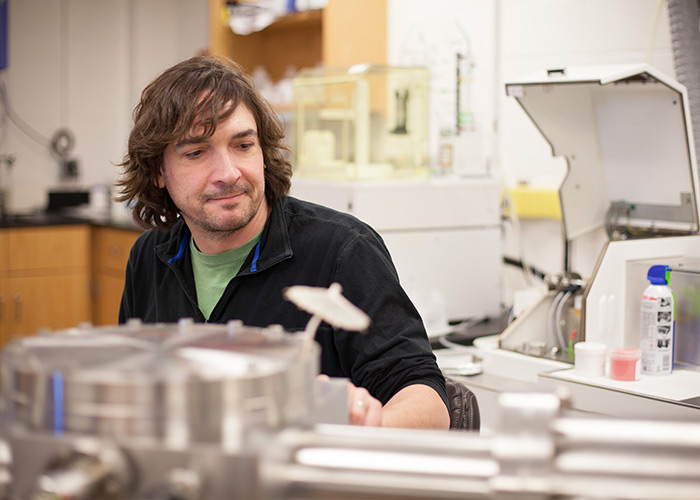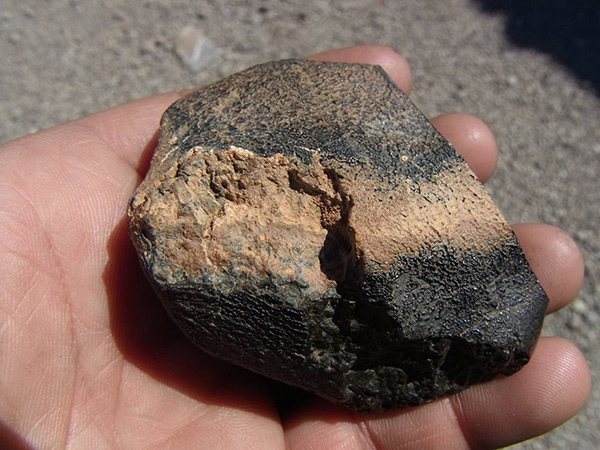Meteorite Offers a Glimpse of Volcanic Rocks from Mars
Analysis of a Martian meteorite has uncovered evidence pointing to at least two billion years of volcanic activity at a single meteorite ejection site on Mars. This discovery confirms that some of the longest-lived volcanoes in the solar system may be found on Mars.
 Tom Lapen is a professor of geology in the College of Natural Sciences and Mathematics.
Tom Lapen is a professor of geology in the College of Natural Sciences and Mathematics.
Related News Items
Popular Mechanics
Space.com
Christian Science Monitor
USA Today
Discovery Channel’s Seeker
Science News
Astronomy Magazine
Radio Interview
UH Moment: Studying the Red Planet These results were published in the journal Science Advances, with Tom Lapen, professor of geology in the University of Houston’s Department of
Earth and Atmospheric Sciences, listed as first author.
Martian Volcano Formation Similar to Hawaiian Islands
Portions of Mars’ surface are studded with volcanoes. Known as shield volcanoes and lava plains, they were formed from lava flowing out over long distances, similar to the formation of the Hawaiian Islands. The largest Martian volcano, Olympus Mons, is 27 kilometers high, almost triple the height of Earth’s tallest volcano Mauna Kea, and 500 kilometers across.
Many meteorites from Mars are samples from these volcanic centers.
Martian Meteorites Provide Clues about the Evolution of Mars
“Learning about another planet is like wearing a blindfold while feeling part of an elephant,” Lapen noted. “If you’re not familiar with what an elephant is, it’s going to take a long time to connect the dots.”
Much of what we know about the composition of rocks on Mars comes from meteorites found on Earth. Analysis of different isotopes provide information about the age of the meteorite, its magma source, the length of time it was in space, and how long the meteorite was on Earth’s surface.
Shergottites: Martian Rocks of Volcanic Origin
 The meteorite, named Northwest Africa (NWA) 7635, was discovered in 2012.About 1.1 million years ago, something slammed into the surface of Mars, hitting a
volcano or lava plain. This impact carved out a crater, ejecting rocks out into space.
About a million years later, fragments of these rocks crossed Earth’s orbit and fell
as meteorites. The fragments provide insight into the history of volcanic activity
on Mars.
The meteorite, named Northwest Africa (NWA) 7635, was discovered in 2012.About 1.1 million years ago, something slammed into the surface of Mars, hitting a
volcano or lava plain. This impact carved out a crater, ejecting rocks out into space.
About a million years later, fragments of these rocks crossed Earth’s orbit and fell
as meteorites. The fragments provide insight into the history of volcanic activity
on Mars.
“We know that volcano formation on Mars is very similar to the formation of the Hawaiian Islands, with layers of lava accumulating over time,” said Lapen, a faculty member in the UH College of Natural Sciences and Mathematics.
The meteorite Lapen analyzed is named Northwest Africa (NWA) 7635 and was discovered in 2012. NWA 7635 was found to be a type of volcanic rock called a shergottite, with an ejection time of 1.1 million years ago. Eleven shergottites have been found with a similar chemical composition and ejection time.
“Looking at the chemical composition of these meteorites, we see that they came from a similar volcanic source,” Lapen said. “Given that they also have the same ejection time, we can conclude that these come from the same location on Mars.”
Shergottites from Single Location Span 2 Billion Years
Together, these meteorites fill in a profile of a single location on Mars. Previously analyzed meteorites range in age from 327 million to 600 million years old. In contrast, the meteorite analyzed by Lapen’s research team was formed 2.4 billion years ago.
“What we are seeing is that the ages of these samples, all of which came from a single ejection event and site, span 2 billion years,” Lapen said. “This means we are looking at a volcanic system that has been active for at least this long and likely longer. These are perhaps some of the longest-lived volcanic centers in the solar system.”
Dr. Minako Righter, a researcher and lab supervisor in the UH Department of Earth and Atmospheric Sciences, was involved with this study along with collaborators from the University of Washington, Aarhus University, University of Wisconsin-Madison, University of California, Berkeley, University of Arizona, and Purdue University.
- Rachel Fairbank, College of Natural Sciences and Mathematics